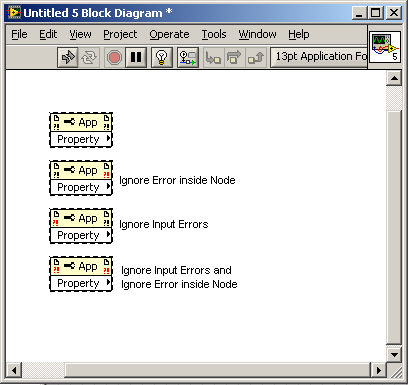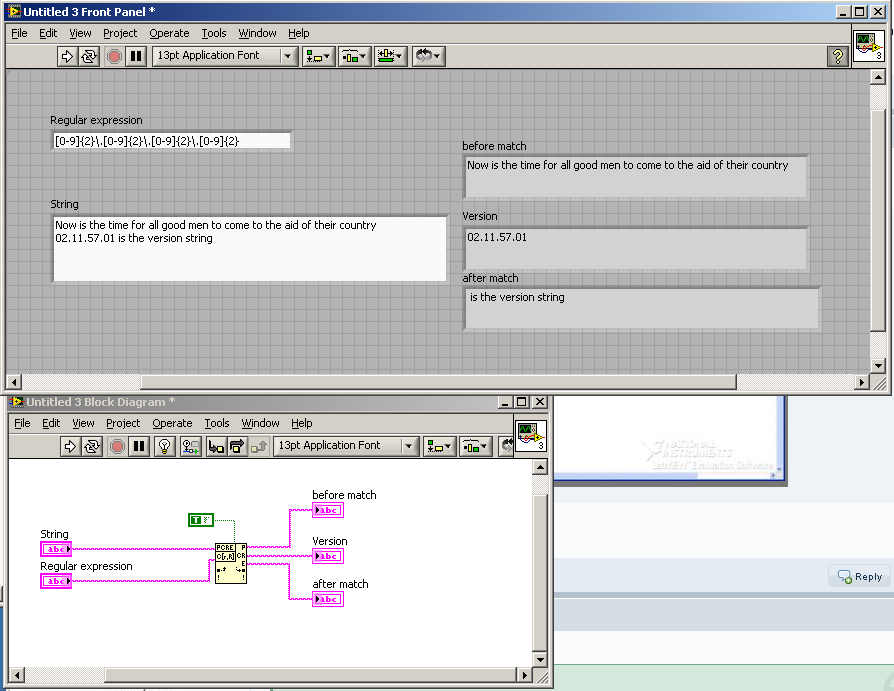-
Posts
429 -
Joined
-
Last visited
-
Days Won
1
Content Type
Profiles
Forums
Downloads
Gallery
Everything posted by Mark Yedinak
-

help for useing SNMP in labview
Mark Yedinak replied to zyh7148's topic in Remote Control, Monitoring and the Internet
Try the attached VI. The problem that your application has is that you are using the low level VIs of the library and you aren't using the higher level VIs which provide the full implementation. snmp communication.llb simple_snmp_get.vi -

help for useing SNMP in labview
Mark Yedinak replied to zyh7148's topic in Remote Control, Monitoring and the Internet
Could you please post you code saved for version 8.6.1? I don't currently have LabVIEW 9.0 installed. Also, have you tried using a LAN analuzer to capture the communication between the devices? This would be useful in determining what is happening. These VI's were written to strictly enforce the SNMP protocol and I have seen at times that some devices don't always format the response in full compliance with the SNMP spec. This can result in a error. I have discovered a few areas where the error reporting in these VI's can be improved. However, it would be most helpful if I could see you code (saved for LabVIEW 8.6.1) to see what is happening. -
Congrats! Welcome to the club.
-

First time FIRST volunteer, any suggestions
Mark Yedinak replied to Mark Yedinak's topic in LAVA Lounge
Mark, At this time I will be working on the one day challenge. I will be attending both the practice day and the actual event itself. At this point it is unclear whethe rI will be working with a single team or if I will be working as a floating mentor. I had indicated that I would like to mentor a team for the FRC but I am still waiting to hear if there are specific teams in my general area that I can work with. There are some teams way down on the simply be impractical for me to be able to mentor them from a travel and time perspective. There was one high school that was on the fence whether they would participate or not again. I guess they had trouble getting people to help them. I would be ideal for this team since the school is about a mile from my house. -
Well I decided to take the plunge and volunteer for the FIRST competition here in Chicago. The local organizer is pretty happy to have me volunteer since she generally has problems finding people in the actual city to help out and I live in the city. Anyway I was wondering if anyone who has done this before has any good advice or suggestions for a newbie volunteer. Thanks
-
Congrats! Good luck on the job search.
-
It depends on his application as both you and Scott discussed. The thought that came to mind though when I read the original post was that he was trying to do polling using an event structure. Like Scott, I try to avoid using the timeout event in an event structure. I also prefer to use events rather than polling. As for a producer consumer architecture being excessive I don't really think it is. At least not for anything that will be an application and interact with a user. It isn't that challenging of an architecture to understand and it provides lots of flexibility and extensibility for an application. It is the architecture of first choice for any application I write. No I'm saying that it is the greatest thing since sliced bread but it is a proven architecture for applications where user interaction will be involved.
-
It sounds like your application could benefit from using a producer consumer architecture. Use a single event structure in one while loop that will detect the value change and have the event notify the consumer of the new value. A state machine in the consumer could process the data as required and if necessary repeat over the action until a new value is detected.
-
You could combine this technique with a class global that defines the name of the SEQ. If would be written to by the very first instantiation of the class. the name could be in the form of the class name with a random number appended to the name. All other methods would access your global data using the SEQ and the randomly generated name to obtain your queue reference. Using this method it would be very difficult for someone outside the class to get a reference to the queue.
-
You should see how shocking it is when it is the same child. My 13 year old really shot up this past year. He grew close to 6 inches in less than a year. Last week I saw some pictures of him from February and he looks like a completely different kid. He went from looking like a kid to looking like a young man virtually over night.
-
Congrats Jim. Enjoy them while they are young. They grow up VERY fast.
-

Multiple protocols and interfaces
Mark Yedinak replied to jcz's topic in Application Design & Architecture
You could still use an OO approach although it would not be native LVOOP. You could use the Endeavo toolkit or dqGOOP for example. We have several classes which were implemented in dqGOOP since they were created back in the days of LV 7.1. We still use them today and they work well. It would be nice to convert them to native LVOOP but we don't have the luxury of the spare time to do that. One of the classes that we have is a generic connection class very similar to what you describe. -
There is no silver bullet answer for your question. It really will depend on what application you will be opening the document in as to what you will need to include in the actual text of the document.
-
I would highly recommend that you consider using VIPM. My group has been using source code control (CVS) for our reuse and it doesn't fully meet our needs. As crelf stated SCC doesn't truly manage your reuse libraries. The nice thing about VIPM is that once you build and deploy your packages your reuse libraries are easily integrated into the LabVIEW environment. You certainly don't want your SCC repository to sit in the users directory of LabVIEW however that is where you want you reuse libraries to exist. If you use SCC only you need to manually integrate your libraries into the user directories under the LabVIEW and this can be a pain not to mention error prone process.
-
If the auto recovery didn't catch it then the answer is no. The ever valuable lesson of computers: save early and save often. Sorry you lost your work.
-

diffrent of "property->Value" and "Local Variable"
Mark Yedinak replied to MViControl's topic in LabVIEW General
That would work too. I was basically suggesting the color to remain consistent with the current "Ignore Errors inside Node". -

diffrent of "property->Value" and "Local Variable"
Mark Yedinak replied to MViControl's topic in LabVIEW General
The way I would envision this to work would be if you select to ignore incoming errors the error input would change from black to red. This would be similar to how the current ignore errors on the inside works. I would also envision this option only affecting the input errors. Internally generated errors would be control by the state of the "Ignore Errors inside Node". If the "Ignore Input Errors" (new feature) is enabled and an error is input then that error would be passed through. If an error occurs on the inside then just like today in most VIs the internal error would overwrite the input error. -

New wire type, the Null wire
Mark Yedinak replied to Mark Yedinak's topic in LabVIEW Feature Suggestions
Thanks for posting the suggestion on the Idea Exchange. -

How many data copies should a graph make?
Mark Yedinak replied to Cat's topic in Development Environment (IDE)
Why can't you read the file in chunks and simply build up the data to pass to the graph? You could preallocate the array used for the graph data and replace it as you read from the file. Once all the data has been read pass the entire data set to the graph for display. -

diffrent of "property->Value" and "Local Variable"
Mark Yedinak replied to MViControl's topic in LabVIEW General
However this implementation would be much more explicit than a subVI which simply passes an error through it. At least here the glyph could be changed just like it is when you ignore errors inside the property node. If someone writes a subVI that ignores the errors other than looking at the code you have no idea that the error will be ignored. And yes, if I had to choose between this feature or the sequence container I would opt for the sequence container. -

How many data copies should a graph make?
Mark Yedinak replied to Cat's topic in Development Environment (IDE)
When working with large files like this I generally try to read the file in chunks. If you can do that you may find that you significantly decrease your memory usage as well as see an increase in the performance. Reading large files in a single read is extremely inefficient, at least based on my experience so far. -
That's what I usually say too.
-

Need help with regular expressions
Mark Yedinak replied to jbabb's topic in Remote Control, Monitoring and the Internet
The following regular expression will extract a version string from the text: [0-9]{2}\.[0-9]{2}\.[0-9]{2}\.[0-9]{2} Here is a condensed version of the regular expression: ([0-9]{2}\.){3}[0-9]{2} It is not clear from your code exactly what you are trying to accomplish though. Screen shot of the code. -

Need help with regular expressions
Mark Yedinak replied to jbabb's topic in Remote Control, Monitoring and the Internet
Can you post more of the surrounding data? Also, are you simply trying to extract the version string out of the data?



